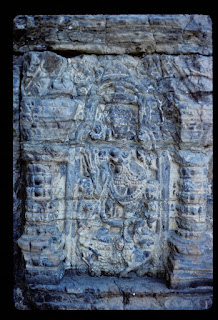( Metallic Harihara from Kashmir )
( Copper Prabhavali from Kashmir )
( Stone sculpture of Vishnu as Varaha from Kashmir )
( A fragment of VishavrupaVishnu recovered from Kashmir )
( VISHNU IN DARK GREY LIMESTONE FROM VERINAAG ( ANATNAAG KASHMIR ) 9TH OR 10TH CENTURY IN SPS MUSEUM SRINAGAR KASHMIR ..)
( VISHNU CARVED IN WALL OF AWANTIPURA TEMPLE RUINS )
( STONE CARVED VISHNU IMAGE AT MARTANDA SUN TEMPE RUINS )
VAISHNAVISM IN ANCIENT AND MEDIAEVAL KASHMIR
The valley of Kashmir has been a great centre of Vaishnavism. There is enough literary evidence for this belief. Books such as the Nilamata Purana.' the Kuttanimata Kavya of Damodaragupta, the Samayamatrika and the Dasavataracaritam of Kshemendra and the Rajatarangini of Kalhana establish it all. These texts inform about the popularity of the cult of Vishnu in early mediaeval Kashmir. Lord Vishnu became the predominant divinity in Kashmir during the period of the Karkota kings. Noted scholar Dr S S Toshakhani writes this:-
“Despite their reverence for Buddha, Karkota rulers of Kashmir were worshippers of Shiva and Vishnu. So were the rulers of the Utpala dynasty, who were ardent followers of Vaishnavism. With Buddhism receding to the background, Shaivism and Vaishnavism gained a dominant position along with the worship of other Hindu gods. Festivals and rituals connected with them gained more popularity, impacting social life in many ways including a renaissance in art and architecture.”
Like Shiva, Vishnu is also seen in many stone sculptures of Kashmir. One can see Vishnu sculptures from Kashmir in various forms and styles on display at the S P S Museum, Srinagar and also in many museums of the UK and the US. These forms could be listed as:-
(1) Vaikuntha -Vishnu
(2) Madhusudana -Vishnu (the destroyer of the demons Madhu and Kaitabha)
(3) Standing Vishnu
(4) Sesayi - Vishnu (Vishnu is believed to have attained this shape at the end of Maha Pralaya or the great deluge of universal dissolution)
(5) Hayagriva -Vishnu (horse-headed Vishnu )
(6) Varaha-Vishnu
(7) Vamana-Vishnu
(8) Natasha –Vishnu
(9) Vishavarupa- Vishnu
The British Museum , London has a 9th century sculpture from Kashmir that shows Viṣhṇu as Varaha . This fragmented / broken sculpture has been done in stone (schist). The Metropolitan Museum of Art, New York has a 6th century stone sculpture of Vishavrupa Vishnu from Kashmir. This idol is displayed at gallery number 237 on the first floor. The idol is fragmented. In this sculpture, Lord Vishnu is shown with ten arms and three faces. He is attended by his lion and boar Avatars, Narasimha and Varaha, along with multiple other forms. Vishavarupa Vishnu is the supreme form of Lord Vishnu where the whole universe is described as contained in him. In Kashmir, Vishvarupa Vishnu was sculpted strictly following the guidelines laid down in the Vishnudharmottara Purana, which text prescribes three heads: a human (centre), a lion (the head of Narasimha, the man-lion Avatar of Vishnu) and a boar (the head of Varaha, the boar avatar of Vishnu) and multiple arms.
Lord Vishnu as Trivikrama has been mostly sculpted in the southern parts of the country. The early Chalukya rulers sculpted it inside the Badami cave temples of Karnataka . However, we find some Vishnu Trivikrama sculptures in Kashmir as well most possibly sculpted during the rule of the Karkota dynasty. Trivikrama Vishnu, who in three steps encompassed the earth, the atmosphere and the sky and gained rulership of the universe. The scriptures inform us that Vishnu assumed the form of the dwarf Vamana and extracted a promise from the demon King Bali and asked that he could have as much land he could cover in three steps. When Bali agreed, Vamana transformed himself into the giant Trivikrama and covered the earth with one stride, the mid-world between the earth and heaven with a second stride and with his third he stepped onto Bali and sent him to the underworld. In this way, Lord Vishnu re-established himself as the master of the universe.
Ancient and mediaeval Kashmir had a grand tradition of Shiva and Vishnu worship. Many Shiva and Vishnu sculptures were created in stone and metal alloys. In line with the prevailing practice in the subcontinent at that time, the Kashmiri sculptors also created a single image of Shankara and Narayana known as Hari-Hara or Shankarnarayan. This suited the Vaishnavites and Shaivites of Kashmir .Many museums the world over have Hari-Hara sculptures from various kingdoms of ancient and mediaeval India. Some Hari-Hara sculptures from Kashmir can be seen in the museums of the US , UK and Germany. In the Museen Dahlem (Dahlem Museums), Berlin (Germany), there are some sculptures relating to the ancient and mediaeval Kashmir. A 9th century soapstone sculpture of Hari-Hara from Kashmir is worth mentioning.

CHINAR SHADE by Autarmota is licensed under a Creative Commons Attribution-Noncommercial-No Derivative Works 2.5 India License.
Based on a work at http:\\autarmota.blogspot.com\.


..jpg)




No comments:
Post a Comment
Note: Only a member of this blog may post a comment.